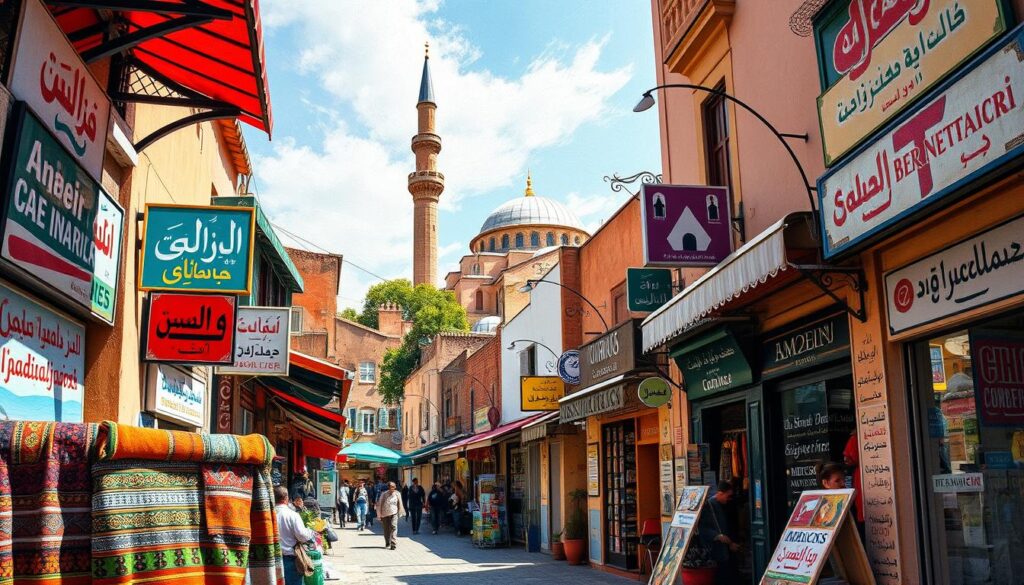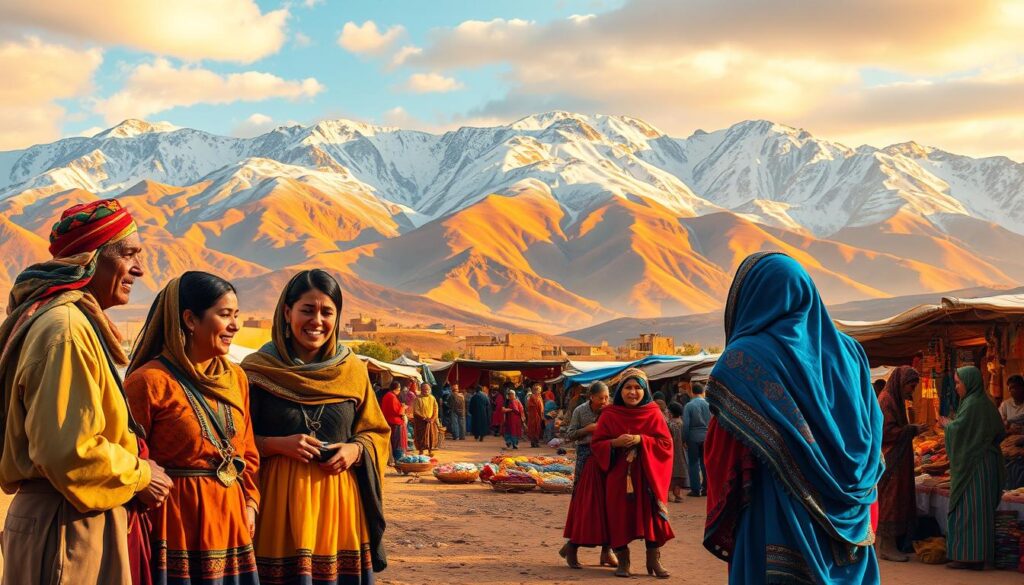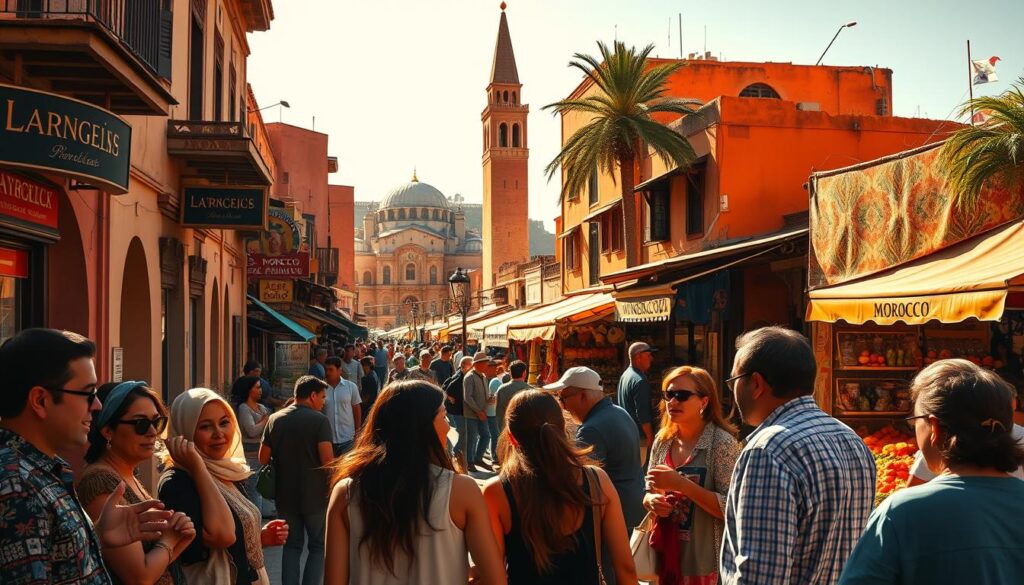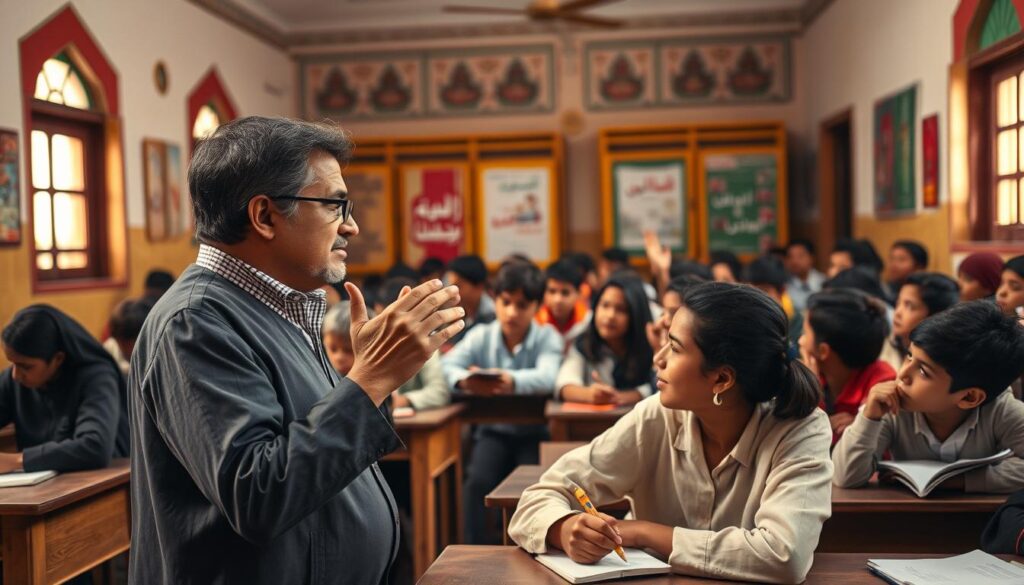Have you ever wondered about the diverse voices that fill the bustling streets of Morocco? From the vibrant markets to the serene countryside, the country’s linguistic landscape is as rich as its cultural heritage.
Morocco stands out as one of North Africa’s most linguistically diverse countries, with a complex history that has shaped its multilingual identity. The official languages, Modern Standard Arabic and Standard Moroccan Berber, coexist with various regional dialects and foreign languages, creating a unique cultural tapestry.
The majority of Moroccans communicate in Darija, or Moroccan Arabic, which differs significantly from the Arabic spoken in other parts of the Middle East. Meanwhile, Berber languages remain vital in rural areas, reflecting the country’s diverse cultural influences.
Key Takeaways
- Morocco is linguistically diverse, with multiple languages reflecting its complex history.
- The official languages are Modern Standard Arabic and Standard Moroccan Berber.
- Darija, or Moroccan Arabic, is the primary spoken vernacular.
- Berber languages are spoken by approximately one-quarter of the population.
- European languages, particularly French, play a significant role in education and administration.
The Linguistic Landscape of Morocco
The linguistic landscape of Morocco is marked by a blend of languages, reflecting the country’s rich cultural heritage. Morocco’s language profile is complex, with multiple languages playing significant roles in different contexts.

Official Languages of Morocco
Morocco has officially recognized two languages: Modern Standard Arabic and Berber (Amazigh). The 2011 constitution marked a significant milestone by elevating Berber to official status alongside Arabic, acknowledging the country’s dual linguistic heritage. According to a survey by Moha Ennaji, there is a general agreement that Standard Arabic, Moroccan Arabic, and Berber are the national languages. This recognition reflects the government’s commitment to preserving indigenous cultural identity.
Multilingualism in Moroccan Society
Multilingualism is a vivid sociolinguistic phenomenon in Morocco, favored by many people. The country’s population navigates between different languages depending on the context, setting, and purpose. Urban centers like Casablanca, Rabat, and Marrakech showcase Morocco’s linguistic diversity, with residents often switching between Arabic, Berber, French, and sometimes Spanish or English. Language in Morocco serves as a marker of identity, education level, and social class, creating a society where language boundaries are fluid.
What Language Do They Speak in Morocco: The Arabic Varieties
In Morocco, the Arabic language is diverse, encompassing both formal and informal varieties that cater to different aspects of society. The country’s linguistic landscape is characterized by the coexistence of multiple Arabic dialects, each serving distinct purposes and used in various contexts.
Modern Standard Arabic
Modern Standard Arabic (MSA) is the formal, standardized version of Arabic used in official contexts. It serves as Morocco’s formal written language, used in official documents, news broadcasts, and formal education. Although it’s rarely used in everyday conversation, MSA holds significant prestige as the language of religion, literature, and formal communication. Most Moroccans consider it almost a second language that must be formally learned in schools. Modern Standard Arabic is crucial for formal communication and education in Morocco.
Moroccan Arabic (Darija)
Moroccan Arabic, also known as Darija, is the true everyday language of Morocco. It serves as the mother tongue for over 90% of the population and is the primary means of communication in homes, streets, and informal settings. Darija differs significantly from Middle Eastern Arabic varieties in pronunciation, vocabulary, and grammar, incorporating numerous Berber, French, and Spanish loanwords that reflect Morocco’s unique history. According to Abdelâli Bentahila, Moroccans who are bilingual in both French and Arabic prefer to speak Arabic while discussing religion, in grocery stores or restaurants, and with family members, beggars, and maids. Moha Ennaji notes that Moroccan Arabic has connotations of informality and is used in casual conversations and spoken discourse.
The relationship between Modern Standard Arabic and Moroccan Arabic represents a classic case of diglossia, where two varieties of the same language serve different functions in society. While Moroccan Arabic dominates oral communication, it has traditionally lacked official status in writing and education, though recent years have seen increasing use of Darija in advertising, social media, and some publications.
Hassaniya Arabic
Hassaniya Arabic, spoken primarily in southern regions and Western Sahara, represents a distinct Arabic variety with closer ties to Mauritanian Arabic than to Morocco’s northern dialects. This dialect showcases the regional variations within Arabic varieties spoken in Morocco, highlighting the country’s linguistic diversity.
Berber Languages in Morocco
Berber languages, also known as Amazigh, are an integral part of Morocco’s linguistic heritage. Approximately 25% of the population speaks one of several Berber varieties as their mother tongue. These languages are predominantly spoken in rural areas and are used in informal contexts such as family, friendship, and street interactions.

Tashelhit
Tashelhit is one of the major Berber languages spoken in Morocco, predominantly in the southern regions, including the Souss-Massa region and the High Atlas mountains. It is spoken by approximately 14% of Moroccans, making it the most widely spoken Berber language in the country. Tashelhit has a rich oral tradition and is an important part of the cultural identity of its speakers.
Central Atlas Tamazight
Central Atlas Tamazight is another significant Berber language, primarily spoken in the Middle Atlas mountain regions. Around 7% of the population speaks this language, which has become the basis for the standardized Amazigh language now taught in schools. This standardization effort is part of the broader initiative to promote Berber languages and culture.
Tarifit
Tarifit, also known as Riffian, is spoken in the northern Rif mountains by approximately 4% of Moroccans. This language shows some linguistic influence from neighboring Spanish territories, reflecting the historical and cultural exchanges in the region. Despite its relatively smaller number of speakers, Tarifit remains an important part of the linguistic diversity of Morocco.
The Amazigh Cultural Renaissance
The 2011 constitutional recognition of Berber as an official language marked a significant turning point in the Amazigh cultural renaissance. This recognition has led to increased visibility of Berber languages in education, media, and public signage. However, challenges such as standardization issues, limited teaching resources, and the dominance of Arabic and French in formal domains continue to affect the Berber languages. The revitalization of Berber culture and language has become an important part of Morocco’s national identity conversation, with growing pride in Amazigh heritage among younger generations.
European Languages in Morocco
Morocco’s linguistic landscape is characterized by a blend of languages, including European languages that play a significant role in the country’s culture and economy. The presence of European languages is a legacy of the country’s historical ties with European nations, particularly France and Spain.
The Prominence of French
French maintains a privileged position in Morocco as the primary language of business, higher education, and administration. Approximately 33% of Moroccans speak French as a second language, and it is widely used in government, banking, and corporate settings, creating a form of linguistic duality with Arabic. The French language serves as a marker of educational attainment and often social class, with fluency opening doors to economic opportunities and international connections. As a member of the Francophonie, Morocco continues to nurture its ties with French-speaking countries.

Spanish Influence in Northern Morocco
Spanish influence remains strong in northern Morocco, particularly in cities like Tetouan, Tangier, and Nador. Approximately 10% of the population speaks Spanish due to historical ties and proximity to Spain. The Spanish language has contributed to the cultural and linguistic diversity of the region, with many Moroccans speaking Spanish as a second language.
Growing Importance of English
English has experienced rapid growth in popularity, especially among younger Moroccans and in the tourism and technology sectors. Recent educational reforms have emphasized English instruction in schools, signaling Morocco’s recognition of English’s growing global importance. As a result, English is becoming increasingly important in Morocco, particularly in urban areas and among the educated population.
Language Policy and Education in Morocco
The evolution of language policy in Morocco is a reflection of its rich linguistic diversity and historical context. Since independence, the country has navigated the complexities of establishing a cohesive language policy that balances the promotion of Arabic, the recognition of Berber languages, and the practical use of French and English in education and governance.
Arabization Efforts
After gaining independence in 1956, Morocco embarked on a process of Arabization, aiming to assert its national identity. The Institute for Studies and Research on Arabization was established in 1960 to spearhead this effort. However, the implementation of Modern Standard Arabic faced challenges, particularly in technical and scientific fields where French was deeply entrenched.
By the 1970s, it became clear that a strict Arabization policy was not without its challenges, with debates around the use of Moroccan Arabic (Darija) versus Modern Standard Arabic.
Recognition of Berber Languages
A significant shift occurred with the recognition of Berber languages as an integral part of Morocco’s linguistic heritage. The 2011 constitutional recognition of Berber as an official language marked a watershed moment, validating the cultural and linguistic rights of Berber-speaking populations.
In 2019, the Parliament voted to expand Berber classes to all Moroccan schools, with about 2,000 schools teaching Amazigh by 2022.

Language in Schools
The language of instruction in Moroccan schools reflects the ongoing tensions and pragmatic compromises in the country’s language policy. Arabic remains the primary language of instruction in humanities, while French often dominates in scientific and technical subjects.
The introduction of Berber language education faces practical challenges, including teacher training and curriculum integration. Recent reforms have also reintroduced French as a medium of instruction for science and mathematics, signaling a shift towards a more multilingual educational approach.
Furthermore, the decision to introduce English earlier in education represents Morocco’s recognition of changing global linguistic dynamics.
Conclusion
Understanding the languages spoken in Morocco provides insight into the nation’s cultural identity. Morocco’s linguistic landscape is one of the most diverse in North Africa, with Arabic varieties, Berber languages, and European languages coexisting in a dynamic multilingual environment.
According to the 2024 Moroccan census, 92.7% of the population spoke Arabic, while 24.8% spoke Berber languages. Moroccan Arabic (Darija) serves as the primary spoken language for over 90% of the population, while Modern Standard Arabic holds official status and cultural prestige.
The country’s linguistic diversity is reflected in its language policies, which have evolved toward a more pluralistic approach. For visitors, basic knowledge of Arabic or French phrases can enhance their travel experience. Morocco’s multilingual character represents both a challenge and an advantage in international relations and commerce, making it a unique cultural identity at the crossroads of Africa, Europe, and the Middle East.